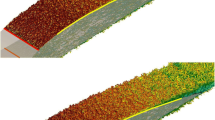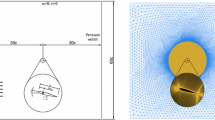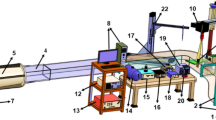Abstract
This research numerically elucidates the effects of suction and blowing on the enhancement of unsteady aerodynamic characteristics of flows and their corresponding impact on stall delay over the well-known NACA0012 airfoil at various angles of attack (\( 12 \le {\text{AOA}} \le 20 \)) under low Reynolds numbers. For this purpose, an in-house solver written in C++ is developed. The numerical code utilizes the Jameson’s cell-centered finite volume numerical method accompanied by a progressive power-law preconditioning approach to suppress the stiffness of the governing equations. Many numerical simulations are performed over the suction-blowing control parameters, namely, the slot location (\( L_{j} \)), suction/blowing amplitudes (\( A_{j} \)), and suction/blowing angle (\( \theta_{j} \)). Most of the analyses are based on the measurements of the unsteady aerodynamic characteristics behaviors (such as lift, drag, moment coefficients, and stall phenomena) over the airfoil. The numerical results confirm that the unsteady behavior of the flow (vortex shedding) is weakened or approximately removed when suction is used, especially near the leading edge. In all of the test cases, the ratio of the average lift coefficient to the average drag coefficient increases with increasing suction and blowing amplitudes, except in the case of perpendicular blowing. Furthermore, the blowing is more sensitive to the blowing angle compared to the suction. From the suction and blowing results, it is concluded that the former has a more positive impact on the lift and drag characteristics, especially in the case of incompressible flow at Low-Reynolds regimes.




















Similar content being viewed by others
References
Hall J (2007) Low Reynolds number aerodynamics for micro aerial vehicles. Ph.D. Dissertation, The University of Colorado at Boulder
Thake MP Jr (2011) Investigation of a Laminar airfoil with flow control and the effect of Reynolds number. Ph.D. Dissertation, The Ohio State University
Gregory N, Walker W (1958) Experiments on the use of suction through perforated strips for maintaining laminar flow: transition and drag measurements. Tech report, Aeronautical Research Council Reports and Memoranda, no. 3083
Cumming R, Gregory N, Walker W (1950) An investigation of the use of an auxiliary slot to re-establish Laminar flow on low-drag aerofoils. Tech report, Aeronautical Research Council Reports and Memoranda, no. 2742
Burrows DL, Schwartzberg MA (1952) Experimental investigation of an NACA 64A010 airfoil section with 41 suction slots on each surface for control of Laminar boundary layer. Tech report, National Aeronautics and Space Administration Washington DC, no. 2644
Anderson G, Murthy V, Sutera S (1969) Laminar boundary-layer control by combined blowing and suction in the presence of surface roughness. J Hydronaut 3(3):145–151
Huang L, Huang P, LeBeau R, Hauser T (2004) Numerical study of blowing and suction control mechanism on NACA0012 airfoil. J Aircr 41(5):1005–1013
Rullan JM, Vlachos PP, Telionis DP, Zeiger MD (2006) Post-stall flow control of sharp-edged wings via unsteady blowing. J Aircr 43(6):1738–1746
Yousefi K, Saleh R, Zahedi P (2013) Numerical study of flow separation control by tangential and perpendicular blowing on the NACA 0012 airfoil. Int J Eng 7(1):10–24
Yousefi K, Saleh R (2014) The effects of trailing edge blowing on aerodynamic characteristics of the NACA 0012 airfoil and optimization of the blowing slot geometry. J Theor Appl Mech 52(1):165–179
Chorin AJ (1997) A numerical method for solving incompressible viscous flow problems. J Comput Phys 135(2):118–125
Turkel E (1987) Preconditioned methods for solving the incompressible and low speed compressible equations. J Comput Phys 72(2):277–298
Van Leer B, Lee WT, Roe PL (1991) Characteristic time-stepping or local preconditioning of the Euler equations. In: AIAA 10th computational fluid dynamics conference, University of Michigan, Honolulu, HI, 24–27 June, pp 260–282
Lee D (1996) Local preconditioning of the Euler and Navier–Stokes equations. Ph.D. Dissertation, University of Michigan
Malan A, Lewis R, Nithiarasu P (2002) An improved unsteady, unstructured, artificial compressibility, finite volume scheme for viscous incompressible flows: part I. Theory and implementation. Int J Numer Methods Eng 54(5):695–714
Malan A, Lewis R, Nithiarasu P (2002) An improved unsteady, unstructured, artificial compressibility, finite volume scheme for viscous incompressible flows: part II. Application. Int J Numer Methods Eng 54(5):715–729
Esfahanian V, Akbarzadeh P (2010) Local pressure preconditioning method for steady incompressible flows. Int J Comput Fluid Dyn 24(5):169–186
Esfahanian V, Akbarzadeh P, Hejranfar K (2012) An improved progressive preconditioning method for steady non-cavitating and sheet-cavitating flows. Int J Numer Methods Fluids 68(2):210–232
Akbarzadeh P, Akbarzadeh E (2016) Hydrodynamic characteristics of blowing and suction on sheet-cavitating flows around hydrofoils. Ocean Eng 114:25–36
Jameson A (1982) Steady state solution of the Euler equations for transonic flow. In: Proceeding of transonic, shock and multidimensional flows. Academic Press, New York, pp 37–69
Jameson A, Schmidt W, Turkel E (1981) Numerical solutions of the Euler equations by finite volume methods using Runge–Kutta time-stepping schemes. In: AIAA 14th fluid and plasma dynamics conference, Palo Alto, CA, 23–25 June
Jameson A (1991) Time dependent calculations using multigrid, with applications to unsteady flow past airfoils and wings. In: AIAA 10th computational fluid dynamics conference, Honolulu, HI, 24–27 June
Belov A, Martinelli L, Jameson A (1995) A new implicit algorithm with multigrid for unsteady incompressible flow calculations. In: 33rd aerospace sciences meeting and exhibit, Reno, NV, 9–12 Jan
Akbarzadeh P, Askari Lehdarboni A, Derazgisoo SM (2018) A new smoothing approach for accelerating the convergence of power-Law preconditioning method in steady and unsteady flows simulation. Int J Mech Sci 141:316–326
Melson ND, Sanetrik MD, Atkins HL (1993) Time-accurate Navier–Stokes calculations with multigrid acceleration. In: Proceeding of the 6th copper mountain conference on multigrid methods, Colorado, 4–9 April, pp 423–439
Hafez M, Shatalov A, Nakajima M (2007) Improved numerical simulations of incompressible flows based on viscous/inviscid interaction procedures. Comput Fluids 36(10):1588–1591
Shatalov AV (2006) Numerical simulations of incompressible laminar flows using viscous-inviscid interaction procedures. Ph.D. Dissertation, University of California, Davis
Zhou Y, Alam Mahbub Md, Yang HX, Guo H, Wood DH (2011) Fluid forces on a very low Reynolds number airfoil and their prediction. Int J Heat Fluid Flow 32(1):329–339
Acknowledgements
The authors would like to thank the Shahrood University of Technology for supporting this study.
Author information
Authors and Affiliations
Corresponding author
Rights and permissions
About this article
Cite this article
Akbarzadeh, P., Askari Lehdarboni, A. & Derazgisoo, S.M. Low Reynolds unsteady flow simulation around NACA0012 airfoil with active flow control. Meccanica 53, 3457–3476 (2018). https://doi.org/10.1007/s11012-018-0898-z
Received:
Accepted:
Published:
Issue Date:
DOI: https://doi.org/10.1007/s11012-018-0898-z




